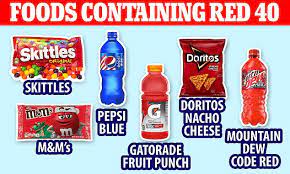The Effects of Artificial Red Food Dye 40

Most commonly known snacks containing red food dye 40. Image courtesy of The Daily Mail (UK).
March 22, 2023
Red food dye 40, also known as Allura Red AC, is a common food additive that is used to give foods and beverages a red or pink color. While it is widely used in the food industry, there are negative effects of red food dye 40 that people should be aware of.
According to, Medical News Today, red food dye 40 has been linked to hyperactivity and attention deficit hyperactivity disorder (ADHD) in children. Studies have shown that consuming foods and beverages that contain red food dye 40 can increase hyperactive behavior and inattention in children. This can lead to difficulty in focusing on tasks and disrupt learning in school.
The Center for Science in the Public Interest released a report that states artificial food dyes pose a “rainbow of risks” from allergies to cancer.
Red food dye 40 can cause allergic reactions in some people. These reactions can range from mild symptoms, such as hives or itching, to more severe symptoms, such as difficulty breathing or anaphylaxis, which is a life-threatening allergic reaction.
Red food dye 40 has also been linked to cancer in animal studies. Although there is no conclusive evidence that red food dye 40 causes cancer in humans, the potential risk is concerning. More research is needed to fully understand the long-term effects of consuming this food additive. It’s banned in Switzerland and the United Kingdom due to health concerns.
An article by Everyday Health discusses digestive problems people have had related to red food dye 40. This includes symptoms such as abdominal pain, nausea, and diarrhea. These symptoms can be especially problematic for people with digestive disorders such as irritable bowel syndrome (IBS) or inflammatory bowel disease (IBD).
In conclusion, while red food dye 40 is widely used in the food industry, there are negative effects associated with its consumption. These effects include hyperactivity and ADHD in children, allergic reactions, potential cancer risk, and digestive problems. It is important for people to be aware of these potential negative effects and to make informed decisions about the foods and beverages they consume.






Ricky Stanicky • Mar 28, 2024 at 9:48 am
This is very insightful! Thank you Kinsey, However I will still be drinking red40.